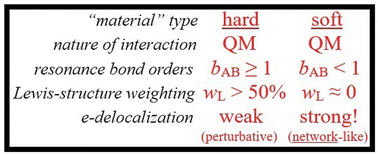In the broad context of Dalton's atomic hypothesis and subsequent classical vs. quantum understanding of macroscopic materials, we show how Pauling's resonance-type conceptions, as quantified in natural resonance theory (NRT) analysis of modern wavefunctions, can be modified to unify description of interatomic interactions from the Lewis-like limit of localized e-pair covalency in molecules to the extreme delocalized limit of supramolecular “soft matter” aggregation. Such “NRT-centric” integration of NRT bond orders for hard- and soft-matter interactions is illustrated with application to a long-predicted and recently synthesized organometallic sandwich-type complex (“diberyllocene”) that exhibits bond orders ranging from the soft limit (bBeC ≈ 0.01) to the typical values (bCC ≈ 1.35) of molecular resonance-covalency in the organic domain, with intermediate value (bBeBe ≈ 0.86) for intermetallic Be⋯Be interaction.
